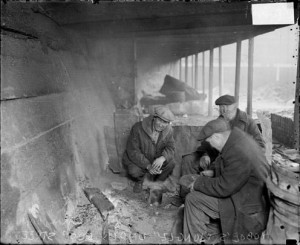The seventh annual Retirement Survey from Wells Fargo, released last week from the company’s headquarters on top of its huge mountain of government money, is thought-provoking. But not in a good way. It is thought-provoking because it reveals so much recklessness, fecklessness, and denial. And those qualities make us stop and wonder, in morbid fascination.
The thought provocation begins with the headline on bank’s press release, which claims that “80 Is The New 65 For Many Middle Class Americans When It Comes To Retirement.” This seems like a pretty chipper observation. Typically, when we say 70 is the new 50, we mean that older people have a vitality that their parents didn’t have, usually because that older generation had the lifeblood sucked out of them by long hours at physically draining work, in and out of the home.
To say that “80 is the new 65” at work has a very different meaning. It means that geriatric employees will have to chose between starving and dragging their sorry, arthritic, broke asses out of bed to go to a job, where they will grind away until their bodies have been spent. Like their parents’ bodies were spent.
It might be the truth, and it might not be anyone’s fault, but it doesn’t warrant an upbeat “X is the new Y” treatment.
That said, the finding that spawned that headline is more disturbing than the headline itself: “A quarter (25%) of middle class Americans say they will ‘need to work until at least age 80’ to live comfortably in retirement.”
So we ask: what kind of work do you think you’ll be able to do when you’re 79, Mr. and Ms. America? We don’t need to tick off the infirmities that pile up with the years, but let’s just note that you don’t want to be swinging a pickaxe in a mine, or trying to keep up with the bar rush waiting tables at 3 AM, or driving a truck through a Wyoming blizzard, or soldering wires for tiny consumer electronic devices.
We can’t find work for robust 35-year-olds who have their hearing and don’t need bifocals to see what they’re eating. And you think you’ll be able to bring home a check when you’re entering you’re ninth decade?
But that’s not the most dissonant part of the study and the release that announced it. There is, for example, this: “Three in ten people (29%) in their 60s have saved less than $25,000 for retirement, possibly indicating they will rely heavily on Social Security.”
The pittance that has been set aside to last 18.6 years (that’s your life expectancy now, the CDC says, if you make it to 65) is a stunning fact. Also stunning is Wells Fargo’s coy observation that this “possibly” indicates a forthcoming heavy reliance on Social Security.
Possibly? You think? OK, some of these folks have defined-benefit pensions. And some will have financially secure offspring who will swoop in and support them. Some might win Powerball. And some might die before they hit 69. Pretty much everyone else will “rely heavily” on those regular checks from the government. Meaning that’s all they’ll have, along with food stamps and Medicare.
And it won’t be nearly enough. That fact is confirmed later in the release: “A 2010 study from the Center for Retirement Research at Boston College estimated that the present value of lifetime uninsured health care costs for a typical married couple age 65 will be $197,000.”
Bottom line: many, many Americans have not saved enough and are not saving enough. Even though these people recognize that they would, in theory, need to work until they’re 80, many of them won’t have the stamina to do so and even if they did, it’s not clear that they’ll be able to compete successfully against young people, who also need to work to live. Put that together, and it says that we’ll see more old and destitute people.
And guess what: it’s happening already. New poverty figures from the U.S. Census Bureau show a large increase in the number of poor Americans, specifically older adults. Using a new formula that factors in health care costs, the agency found that the number of Americans aged 65 and over in poverty nearly doubled to 15.9 percent, or one in six individuals. That’s not a lot more than the 18-64 group, which had 15.2 percent in poverty, but one day that cohort will go back to work. And old people…not so much.
Photo of “three hobos sitting under a covered structure in Chicago, Illinois, 1929” from the Chicago Daily News via Wikimedia Commons. Text on image reads: “Hoboe’s ‘Jungle’ Under Loop Street.”










